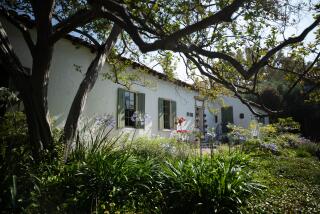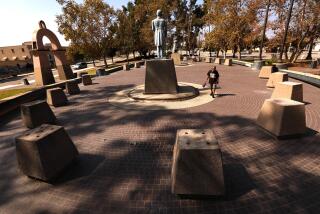EAST LOS ANGELES : 1495 Battle Plan Is Today’s Lesson Plan
- Share via
Elba Bernal reached into a clay-figure scene of Spanish conquistadors and Tainos, the indigenous peoples of the Dominican Republic, picked up an Indian figure and bent its arm to make it look like it was pulling an arrow from a quiver.
The 10-year-old student at Hamasaki Elementary School then returned the Taino figure to the battle scene, where 500 others molded by fourth- and fifth-grade students re-create the March 24, 1495, battle of La Vega Real.
Nearly every day for three months, 12 youngsters have been researching, sketching, chronicling and molding their battlefield, re-creating the fight in which 200 of Christopher Columbus’ men, led by his brother Bartolome, decimated the tribe of 1,000 Tainos in the central valley of what is now the Dominican Republic.
“Nobody’s life is like the Tainos’,” Elba said. “They shared everything. The conquistadors thought they were dumb because they didn’t have clothes, but they were real healthy. They lost the battle because (the Spaniards) had weapons to fight and the Tainos had weapons to hunt.”
Led by artist Rudy Mercado and his wife, artist Nadine Novack, the students will take the battle through four stages that will kill off many of the figures they have created and burn down the village they have made of clay.
The project, an outgrowth of works in which Mercado has depicted historical battles as art in galleries throughout Los Angeles, was funded by the City Cultural Affairs Department and the California Community Foundation.
Mercado has focused on California history and recently started studying the European conquest of the Americas. He chose the battle of La Vega Real to illustrate the life of the Tainos, a little-known civilization, and fill in gaps left in history books.
It has proven a valuable lesson to the students, who were chosen from a combined bilingual class of teacher Ponce Marquez.
“I didn’t know they shared things,” said Louie Sanchez, 11. “I thought they used to fight with each other like we do right now, but they didn’t.”
Mercado developed his interest in dioramas from his father, who helped him and his brother construct them while the pair were growing up in the San Fernando Valley:
“We called (the diorama) a clay table and it was a very disciplined project. My dad, my brother and I would build a piece and in one day we would animate it and destroy it. That was a very special, private toy of our family.”
As he grew up, Mercado abandoned the diorama to become a painter, but eight years ago took up the concept to illustrate military history.
“I’ve had critics who say, ‘Why deal with such a negative image?’ ” Mercado said. “I feel this is valid information for (the students). Violence is such a big factor in our society. We can learn so much from it and (military history) has been very romanticized. With this, we can present the image of war in a realistic way.”
The smoke coming from the Spaniards’ guns is cotton held up by a wire. The mango, banana and palm trees are spray-painted masking tape held up by wires. Each figure, from the Taino chief Guarionex to the birds in the trees and the dogs and horses of the Spaniards, were formed after studying illustrations in books.
The students explain their work to visitors and students who tour the display. It is open to the public through June 18 from 8:30 a.m. to 2:30 p.m. Monday through Friday at the school, 4865 E. 1st St.
More to Read
Sign up for Essential California
The most important California stories and recommendations in your inbox every morning.
You may occasionally receive promotional content from the Los Angeles Times.













